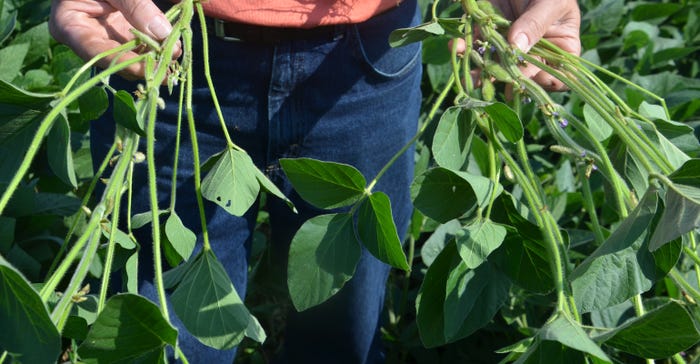
You’ve likely heard reports about soybean stands with as few as 50,000 plants per acre turning out 50 to 60 bushels per acre or more and shook your head. How can that happen?
Steve Gauck did a simple experiment when he visited the Soybean Watch ’19 field midseason to demonstrate the power of compensation in soybeans. He pulled plants from thicker spots in the field and then plants from thinner spots.
Each time, he counted nodes on pairs of plants. The results? The plants had varying amounts of nodes.
“The plant from the thicker area where soybeans had lots of neighbors had one main branch with nodes,” says Gauck, a Beck’s sales agronomist based near Greensburg, Ind. Beck’s sponsors Soybean Watch ’19.
“On that plant, I counted 19 nodes, going to the very top and assuming flowers and pods forming at the very top nodes would go ahead and make beans,” Gauck says. Soybeans were in the R3 reproductive stage, or flowering and producing small pods, when he made these counts.
“The plant from an area which was thinner, where it didn’t have as many neighbors, had a main stem, but it also had two extra branches on it, each with a considerable number of nodes bearing flowers and pods,” he says. “I counted just about 60 nodes on that entire plant, including the branches.”
That’s three times as many pods. Was this an extreme example? Probably, but it proves how much soybeans can compensate to make up for missing neighbors, Gauck says.

WHICH WOULD YOU PICK? Which will yield more? The plant on the left is from an area with a higher population; the plant on the right is from an area with lower population but has more branches.

Nodes matter
Especially this year, it’s all about the number of nodes per acre, Gauck says. Later-planted soybeans tend to be shorter because flowering begins before vegetative growth is finished. That’s why many agronomists suggested increasing seeding rates as planting dates moved into June. At that point, the best way to try to get more nodes per acre was to put more plants out there, he says.
The Soybean Watch ’19 field was planted June 12 to two varieties. Soybeans were no-tilled into cornstalks with a John Deere 750 drill. Heavy rains and a cool spell followed, beginning about three days after planting.
“We still have reasonably good stands here,” Gauck says. “Our July count was about 124,000 plants per acre for one variety and 107,000 for the other.” The variety with the higher plant population per acre was treated with a complete seed treatment, and the other variety was not. Both were treated with Ilevo to protect against sudden death syndrome.
Both stands should be sufficient to produce good yields if weather cooperates, he adds. Gauck says in a normal year, he doesn’t worry if there are at least 80,000 plants per acre.
“From what I saw making these comparisons, plants in the thinner spots are putting on branches, and total nodes per plant are good,” Gauck says. “How final yields turn out will depend on weather and timing. Rain in September to finish out bean size will be critical.”
About the Author(s)
You May Also Like




